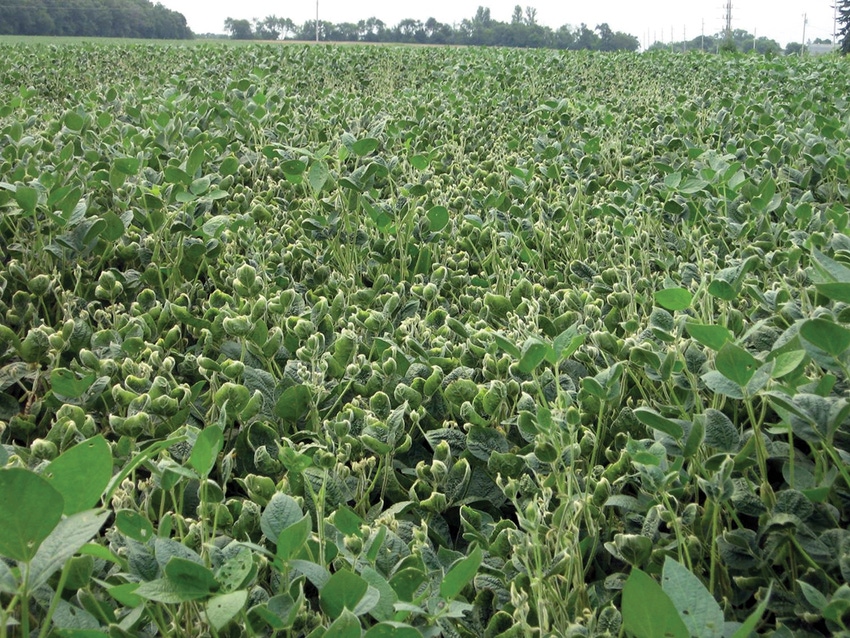
Dicamba drift complaints up sharply in 2017
•More than 50 complaints of damage from dicamba drift have been filed with the Arkansas State Plant Board so far in 2017, up from a total of 32 in 2016.•Northeast Arkansas fields are the hardest hit, largely because many growers there are using Xtend cotton and soybeans to combat glyphosate- and PPO-resistant pigweed.•About 100 acres of soybeans in Division of Agriculture research plots at Keiser were damaged by dicamba drift — interrupting a dicamba drift and volatility study.

More than 50 complaints of crops damaged by dicamba herbicide drifting from neighboring farm fields have been reported to the Arkansas State Plant Board so far in 2017.
That number is up sharply from 2016, in which 32 dicamba drift complaints were filed in the entire year, said Tom Barber, Arkansas Extension weed scientist.
Among the damaged crops are some 100 acres of soybeans in Division of Agriculture research plots at the Northeast Research and Extension Center at Keiser in Mississippi County. Ironically, those soybean plots were part of research by Division of Agriculture weed scientist Jason Norsworthy on dicamba drift and volatility.
The dicamba drift and volatility trials, for herbicide products from Monsanto and Syngenta, are needed before the products can be certified for use in Arkansas. The damage from unexpected dicamba drift interrupted the trials, making Norsworthy’s data useless in most of the plots unless he replants and starts over.
Nearly 100 acres of those plots are being replanted. Forty acres of Xtend soybeans -- a variety from Monsanto that has engineered tolerance to dicamba -- were undamaged by the drift.
Dicamba is a highly regulated herbicide in Arkansas, largely because most soybean varieties are highly sensitive to the herbicide.
Current regulations require applicators or anyone spraying dicamba to undergo training and to pass an applicators exam that covers all requirements for use in Arkansas. Those regulations restrict application to certain weather conditions and require 100-foot buffer zones around the entire field where dicamba is being applied. They also require a quarter-mile buffer between the field and sensitive crops located downwind from the application area.
Monsanto released Xtend cotton in 2015 and Xtend soybeans in 2016. Their tolerance to dicamba allows farmers to apply the herbicide “over the top” of their crops to control weeds.
Barber said the increase in drift complaints is partly because many more farmers are using Xtend soybeans and cotton with dicamba this year to combat glyphosate-resistant pigweed. “Nearly all cotton and a significant percentage of soybeans in Arkansas are Xtend varieties this year.”
Jeremy Ross, Extension soybean agronomist, doesn’t have hard numbers but estimates about 40 percent of Arkansas soybean fields are planted with Xtend beans. The highest percentage of those Xtend soybeans likely are in northeast Arkansas, where many growers are dealing with glyphosate-resistant pigweed.
That area is also where most of the dicamba drift complaints are originating.
Beyond northeast Arkansas, Ross said, there are pockets of growers using Xtend technology, mostly in cotton-growing areas. “The farmers want to use one technology. If a farmer has Xtend cotton, he’s more likely to use Xtend soybeans so that he doesn’t have to worry about switching herbicides.”
Contributing Factors
A number of other things besides the increased use of Xtend crops are contributing to the increase in dicamba drift complaints.
The chief reason, Barber said, is non-Xtend soybeans are so highly sensitive to dicamba. “As we have seen in our research, a very low rate of dicamba can cause soybean leaves to cup. There will not be any yield loss at this low of a rate, but you will see the symptoms on the beans.”
The weather may have had something to do with at least some improper applications.
“Bad weather makes it very difficult to get in the fields and make proper applications,” Barber said. “A lot of farmers or applicators may have sprayed in conditions that were not ideal for spraying, but were ideal for drift, but we rely on the Plant Board to make these final determinations.”
Because of high winds during the day, Barber has heard some may have chosen to spray at night when there was no wind. But temperature inversions are common when there’s no wind at night, holding the volatile spray above the canopy. Drift can then occur when wind returns in the morning.
“I believe that physical drift accounts for at least 80 to 90 percent of all the dicamba injured fields that I have walked and observed patterns of injury,” Barber said.
While improper application may account for much of the reported dicamba drift, Barber said most farmers and applicators are following the regulations and applying dicamba properly.
Even so, 10 to 20 percent of the injury has occurred even when everything appears to have been done correctly. “These are the fields that have me scratching my head wondering how on earth the dicamba symptoms appeared a quarter mile upwind from the reported application.”
Barber said one likely possibility is that dicamba droplets are attaching to dust particles after applications are made. “I am seeing more and more evidence in the field that points toward dicamba moving with dust.
“I don’t know how we can steward a dicamba herbicide when non-Xtend soybeans are so sensitive to it. It is evident that, even when applications are made correctly, sometimes that is not good enough.”
What to do
“The first thing you should do if you suspect dicamba injury from off-target movement is call the Arkansas State Plant Board,” Barber said. “This will provide an official record of the complaint.”
Once the injury has occurred there is nothing that can be done or sprayed on the soybeans to help reduce potential yield losses. It can take up to three weeks before full symptoms of dicamba drift are seen.
Norsworthy said damage done early in the plant’s growth cycle will have little effect on yields. “But when you get dicamba on them around flowering, our research shows some damage to yields, depending on growth stage.”
About the Author(s)
You May Also Like





